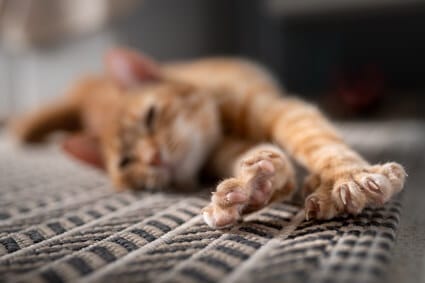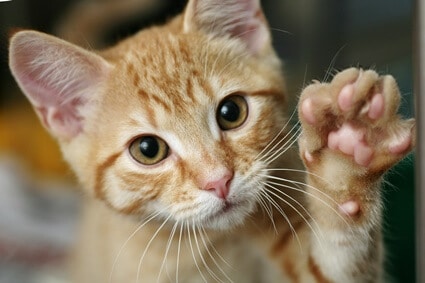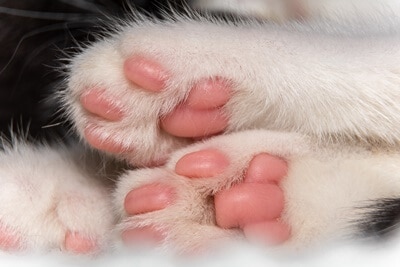If your pet jumps onto your lap, it can be a huge surprise to discover that your cat’s paws feel cold to touch. It’s usually perfectly normal, but paws that never warm-up can sometimes be a sign of sickness or injury.
If your cat’s paws are always cold, it could be due to poor blood flow and circulatory issues. Explanations include hypothermia, heart disease, low blood pressure, shock, blood clots, and general anesthetic.
Unless your cat has just left a cold surface area or has been outdoors during the winter, its feet should stay at a relatively warm temperature. Cold paws suggest that blood is not reaching the extremities.
What Temperature Should My Cat’s Paws Be?
Your cat needs to have a body temperature of between 99.5 and 102.5 degrees Fahrenheit.
You can use the following methods to check:
- Rectal Thermometer
- In-Ear Thermometer
Check that your cat’s temperature falls in a healthy range. Also, ensure that your cat’s feet start to warm up after it’s been indoors for 20-30 minutes. A cat’s paws can tell you when it’s overly hot or too cold.
A cat’s paws and ears are its extremities. If your cat is unwell, it’ll struggle to retain heat in its feet. If your cat’s paws are constantly cool to the touch, this suggests that something is amiss with your cat’s health.
Why Do Cat’s Paws Get Cold?
A cat’s paws are like conductors for its ambient temperature. The paw pads on feline feet are sensitive, so if the ground outside is cold, its paws will reflect the lower temperature.
If your cat usually roams outdoors, discourage this behavior during snowy spells and freezing weather during the winter. Its paws will get so cold that they’ll start to affect your cat’s body temperature.
Its paws will also be cold if it has been walking on cold stone or tiles, but this will be a temporary issue. The paws should quickly normalize once your cat returns indoors to a warm, carpeted room.
If your cat’s paws are constantly cold, there may be a medical explanation. The causes of cold feet in cats include:
- Hypothermia
- Shock
- Low blood pressure
- Heart disease
- Anesthesia
- Blood clots
Check your cat’s body temperature if its paws feel cool to the touch.
Check for other symptoms if its temperature is normal (between 99.5 and 102.5 degrees Fahrenheit). Further investigation is required if your cat is lethargic and not eating or drinking.
Hypothermia
Hypothermia (dangerously low body temperature) is the most common cause of cold feline paws.
Hypothermia has three stages:
- Mild hypothermia. A temperature of 90-99 degrees.
- Moderate hypothermia. A temperature of 82-90 degrees Fahrenheit.
- Severe hypothermia. A temperature below 82 degrees.
Hypothermia can occur when a cat is exposed to cold temperatures for a prolonged period of time. For example, wet fur can cause hypothermia, especially in longhaired breeds of cats.
The most common signs of hypothermia in cats include:
- Shivering
- Shallow, labored breathing
- Slow heart rate
- Dilated pupils
- Lethargy
A cat with hypothermia must be warmed up steadily, so wrap your cat in a thick blanket. If hypothermia is moderate, put a hot water bottle under the blanket. In severe cases, IV fluids will need to be administered by a vet.

Shock
Shock is always a possibility if your cat has a traumatic experience.
Signs that your cat’s in shock include:
- Vomiting and diarrhea
- Withdrawn demeanor
- Weakness and lethargy
- Tremors and seizures
- Pale and discolored gums
If your cat is in shock, its body temperature will drop alarmingly, leaving it at risk of hypothermia. To assist a cat in shock, wrap it in a warm blanket and do your best to keep it calm.
Low Blood Pressure
Low blood pressure (hypotension) is comparatively rare in cats, but it can be a side effect of other conditions. In some cases, it’s hereditary and inherited from a parent.
If your cat has cold paws but seems otherwise normal, hypotension could be the explanation. It’ll find it hard to maintain its body temperature because the blood won’t reach the extremities.
Dealing with hypotension involves treating the cause, such as blood loss, shock, or an underactive thyroid (hypothyroid.)
Heart Disease
Cats with heart disease (cardiomyopathy) fall into four categories:
| Hypertrophic cardiomyopathy (HCM) | The heart muscles thicken, so less blood is pumped through the body. Less blood reaches the paws. |
| Dilated cardiomyopathy (DCM) | This is where the heart muscles become thin. The heart enlarges and cannot pump blood to the paws. |
| Restrictive cardiomyopathy (RCM) | The heart’s wall will become stiff and rigid. Blood cannot reach the heart in order to be pumped around the body. |
| Intermediate cardiomyopathy (ICM) | This is a combination of HCM and DCM. |
Medication and Anesthesia
Cats’ bodies don’t always respond well to certain drugs.
A general anesthetic will leave your cat with cold extremities for a while because its heart rate drops while in surgery.
A vet will monitor your cat’s post-operative heart rate and temperature. They won’t discharge your cat until it’s safe, so keep your cat warm in the interim.
If your cat has cold paws for a prolonged period after getting a vaccination, it may be experiencing an allergic reaction or be in a state of shock.

Blood Clots
Blood clots cause cold paws because they prevent the blood from flowing to the extremities, especially the back paws.
If your cat’s paws turn blue, it likely has a blood clot. Its paws are not receiving any blood/warmth, so it will also struggle to walk on the affected leg(s) and may cry out in pain. According to MSPCA Angell, Plavix (Clopidogrel) is a cat-safe blood thinner administered by vets.
Heart problems and obesity usually cause blood clots. The clot will require blood-thinning medication (Clopidogrel).
One of My Cat’s Paws Is Cold
You may find that your cat has warm front paws but cold back paws. Alternatively, it may just be that just one paw feels cold, which is more concerning than all four paws having a low temperature.
Is your cat limping or avoiding using that leg? This could imply that your cat has an injury or fracture. If so, blood may not reach one paw due to swelling or blockage.
If your cat has cold paws, it’s most likely to be a passing issue. For example, your cat has been walking on tiles or marble flooring. However, constantly cold feet in cats could be an early warning sign of hypothermia or heart disease.


senior cat, always cold feet, had thyroid, glucose checked all good. wobbly and falls off counter, would eat a bottle of china lily soya sauce if you let her, loves human food hates cat food, will even eat dog food. wondering if she would be lacking something that is in cat food.(would live on temptations if we let her) she is 10 yrs and indoor spayed, have grass growing inside for her whenever she desires. she goes crazy for corn husks and will steal corn leftovers if possible.